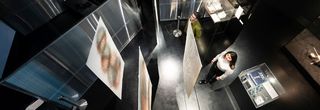Proxy 21
The Proxy 21 series is part of my project Leerstelle des Unbekannten/Nichts stimmt mehr [Empty Space of the Unknown/Nothing’s Right Anymore], which has been ongoing since 2015. That’s the year I listened to a radio programme called Die Abschaffung der Gene [Doing Away with Genes]. I was already familiar with the subject of genetics through my project Vor Haupt Nachspeise (2012-2016) at the Max Planck Institute for Molecular Genetics in Berlin. The radio programme’s catchy title drew my attention to the findings of the international Human Genome Project in 2003. Its findings were said to have shocked the scientific community. The results of the research were such that new links now had to be searched for. Indeed, it transpired that the current knowledge assumed to be true – namely that genes were the main factor responsible for the hereditary process – was in fact incorrect. Some scientists were therefore advocating ‘doing away with genes’.
I decided to apply this state of affairs – i.e. needing to look for new links even though the discipline itself had previously been thoroughly researched – to my own artistic research into drawing. I was keen to re-examine and reconsider this particular discipline. For my experimental set-up I proceeded as follows: I would define an approach to drawing as one might a set of rules and then adopt that approach over a longer period of time and see where it took me. Could such a reiteration eventually give rise to something new, to something different within a framework I myself have staked out? Each series is titled Proxy and has a consecutive serial number.
Proxy Drawing Technique (PDT): Draw brisk, flighty lines with a pencil in each hand. Make use of all the pencils in the pencil box to create a dense network of lines. Have your right hand move around the right half of the paper; your left hand, around the left half. The actual rules are openly formulated so I can follow spontaneous ideas and impulses.
Different work phases in the Proxy series from 2015 to 2022:
For the first series, Proxy 1, I used PDT to draw the letters A, G, C and T on large-format sheets of paper, reflecting the fascinating concept of genetics that all the information for all future living beings is contained in the base pairs adenine, guanine, cytosine and thymine.
Through the repetitive act of drawing, my associations gradually evolved to become cells, molecules as the smallest units of life, and so from that point onwards I began to draw rounded shapes.
In a subsequent work phase, I became aware of the physical environment in which I was drawing. How did its structure actually influence PDT whenever I left the drawing table? Must I modify PDT by incorporating the environment? The Proxy 21 series was one of the first series of this kind. It was created in 2019 during a residency scholarship at the Science Art Philosophy Lab in Lisbon. I was interested in the different textures of the smooth, uneven studio walls and so, using PDT, I decided to draw on paper affixed to those surfaces. I rotated the papers several times while drawing.
I am currently an associate member of the Young Academy for Sustainability Research at the Freiburg Institute for Advanced Studies. My involvement with the topic of sustainability has led me to draw directly onto the walls, without paper, using the PDT.
Katrin von Lehmann, January 2023
Epigenesis and morphogenesis and Katrin von Lehmann’s Proxy drawings since 2015
Hanne Loreck
A (natural) science experiment can be observed in at least two ways. In the first instance, the focus is on monitoring the process until the assumed result occurs; in the second, the observers focus all their attention on the process itself. The confirmation of the hypothesis represents one pole; recording the deviations from the ‘normal course’, the other. Any such irregularities make new and unknown aspects conceivable in the first place, open-ended, and contrary to the scientific requirement for the reproducibility of an experiment. Conceived as a path – or, indeed, a methodology, from the Greek méthodos meaning ‘systematic course’ – they veer off from the planned course and head towards the (literally) unexpected.
Empty Space of the Unknown/Nothing’s Right Anymore (since 2015) belongs in the latter category, with Katrin von Lehmann transferring the setting for a (natural) science experiment to her artistic practice. The artist appropriates the general reference framework for researching certain (scientifically explosive and topical) phenomena in order to then achieve two things: using the key data for such an exploration, she produces a new and discrete reality. This ‘new’ reality manifests itself as a work of art; it ‘is’ an autonomous aesthetic object. But all the while the reality of the aesthetic remains a visual and methodological reference structure in which the transfer of the experimental system to an artistic production says something about the acquisition of scientific knowledge per se. Topically, the aesthetic analogies apply to the complex field of molecular biology with its research into the structure, function and expression of the gene.
Excerpt from the book: Katrin von Lehmann, textura performativa 5, 2021 (on sale at the Museum Shop)
